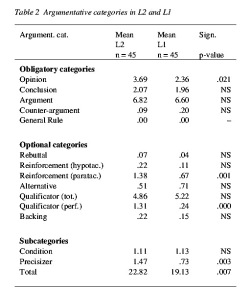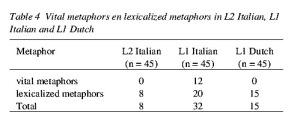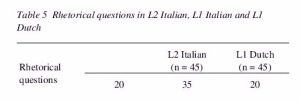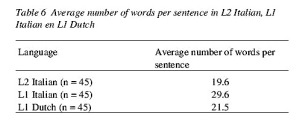ISSA Proceedings 1998 – Linguistic And Pragma-Rhetorical Characteristics Of Argumentative Discourse In L2 And L1
No comments yet 1. Introduction
1. Introduction
The following fragment has been taken from an argumentative essay in Italian, written by a native Dutch university student of Italian. The essay argues that even in a unified Europe, the single European countries will not loose their national identity.
(1) Unificazione europea: perdita dell’identità nazionale?
Non penso che l’unificazione di Europa sarà una perdità dell’identità nazionale (Opinion 1). Secondo me Europa è formato di molto paesi che hanno tutto i propri valori e le proprie tradizione. Questi valori e tradizione sono formati per molti secoli e non camberanno di colpo (Argument 1). Certo, ci sarà uno scambio dei valori e delle tradizione tra i paesi (Counterargument 1 rejected) ma penso che questo scambio sarà utile per arricchere la propria cultura (Argument 2). Ci sono anche le lingue che sono molto diverse (Argument 3). L’inglese sarà la lingua principale (Counterargument 2 rejected), ma penso che non sia possibile (Qualifier 1) di trasformare tutte le lingue nell’inglese (Argument 4). Per me l’unificazione vuol dire che Europa sia un insieme di paesi separati con un zielo uguale: la collaborazione sul campo economico e politico (Conclusion 1).
(European unification: a loss of national identity?)
I don’t think the unification of Europe will lead to a loss of national identity (Opinion 1). In my opinion Europe consists of many countries and each of them has its own values and traditions. These values and traditions have developed over many centuries and will not change all of a sudden (Argument 1). Of course, there will be an exchange of values and traditions between countries (Counterargument 1 rejected), but I think this exchange will be useful and will enrich each country’s culture (Argument 2). Also the languages are very different (Argument 3). English will be the main language (Counterargument 2 rejected), but I think it will be impossible to transform all languages into English (Argument 4). For me unification means that Europe will be a mixture of separate countries with one common goal: collabaration in the fields of economy and politics (Conclusion 1).][i]
To defend his point of view, introduced by standpoint markers like I think, I don’t think, in my opinion, for me, the writer puts forward four arguments. The text also contains a qualifier to mark the degree of certainty with which he regards his standpoint, a conclusion and two counterarguments, which are rejected by the writer. There are only few connectives or argumentative indicators, such as because and consequently. Figures of speech such as metaphors and rhetorical questions are absent. In spite of several language errors, the argumentation is nonetheless adequate.
Producing written argumentative discourse in a foreign or a second language (L2) is a fairly demanding task. L2 writers have to acquire a number of lexical and syntactic devices to enable them to use the argumentative categories that are included in the macro-argumentative structure. The argumentative function of an utterance can be marked linguistically by means of argumentative indicators or by other lexical and syntactic devices (verbal constructions, morpho-syntactic marking, communicative formulas, performatives), which L2 writers must be able to handle. They must also be acquainted with L2 pragma-rhetorical and stylistic conventions.
These are largely language specific and relate to the types of arguments that can be used, the sequence of these arguments, the choice of register, the psychological distance between writer and reader, and the use of modality markers and figures of speech.
Although L2 writers are likely to transfer to L2 a large number of the cognitive, metacognitive and argumentative skills acquired in their mother tongue (L1), the argumentation structure of their texts may be negatively affected by linguistic deficiencies in their L2 knowledge and by their lack of knowledge of the pragma-rhetorical and stylistic patterns of L2. As a result, the argumentative essays in L2 and L1 may differ in complexity and in the occurrence of different argumentative categories. The same may be true for the use of argumentative indicators, modality markers and other lexical and syntactic devices. There may also be differences in the use of figures of speech and other pragma-rhetorical devices.
2. Research questions and experiment
In this article some of the results are discussed of a comparative study of the linguistic and pragma-rhetorical characteristics of argumentative discourse in Italian as a second language and Dutch as a first language. The following research questions are addressed:
1. To what extent does the macro-argumentative structure in L2 differ from L1, with regard to the occurrence of obligatory and optional argumentative categories and subcategories and the use of hypotactical versus paratactical structures of argumentation?
2. What differences can be observed between L2 and L1 concerning the use of argumentative indicators and other lexical and syntactic devices employed by the writers for the marking of obligatory and optional argumentative categories and subcategories?
3. What is the role in L2 and L1 of pragma-rhetorical devices with an indirect argumentative function, such as metaphors and rhetorical questions?
The experiment on which the study was based, was carried out among a group of 85 university students at the University of Amsterdam. The subjects were all in their third year. Their language proficiency in Italian ranged from lower-intermediate to upper-intermediate. The participants were asked to write two argumentative essays, one in Italian and one in Dutch. On the basis of global scoring by three independent judges, the L2 essays were grouped intro three proficiency levels (level 1, 2 and 3). 15 essays of each proficiency level were selected for the analysis of the argumentation structure. To gain a better insight into the use of argumentative indicators and pragma-rhetorical devices in native Italian in comparison with L2 Italian, the essays written by a group of 45 native Italian exchange students at the University of Amsterdam were also analyzed.
3. Language independent and language dependent skills
Writing argumentative prose presupposes a number of cognitive operations: Identification and Differentation (a writer points to the existence of something by designating it), Stabilization and Destabilization (the writer chooses to speak of this rather than that), Appropriation and Relinquishing (the degree to which the writer identifies with something; this may include all possible degrees of conviction, belief, certainty or prudence (Vignaux 1991). Apart from these cognitive operations, writers make use of metacognitive skills connected with the writing process. In the well-known process models of writing by Flower and Hayes (1981) and Bereiter and Scardamalia (1987) several metacognitive components of the writing process are distinguished, such as planning, monitoring, evaluation, generation and selection of content and transformation and coding of thoughts into written language.
A number of specific argumentation skills are also required. Taking into account the type of reader he is going to write for, the writer of an argumentative text has to make clear his positive or negative commitment to a point of view. This point of view has to be supported not only by good arguments, but also by possible counterarguments or rebuttals. Once the arguments and counterarguments have been found, the argumentation structure has to be drawn up and the internal organization of the single arguments (the argumentation scheme) has to be established. The argumentation structure can be simple or more complex, depending on how the writer organizes the defence of his standpoint and relates it to doubts and criticisms. The argumentation scheme characterizes the type of justification provided for the standpoint (Garssen 1997; Van Eemeren, Grootendorst & Snoeck Henkemans 1996: 16-19).
The cognitive, metacognitive and argumentation skills acquired in L1 are language independent. They constitute the basis of a learner’s L2 argumentative competence as well. In addition, L2 argumentative competence consists of L2 pragma-rethorical and linguistic skills. These skills are largely language specific and have to be acquired specially for L2. In the acquisition of the lexical, syntactic and pragma-rhetorical devices required for the production of argumentative discourse and in the use of argumentative indicators linguistic and pragma-rhetorical transfer from L1 to L2 may occur (Odlin 1989; Kasper 1992; Kasper & Schmidt 1996). L1 transfer doesn’t necessary lead to errors, because parallelism of L1 and L2 may also be a facilitating factor. Transfer may also result in learners overusing argumentative indicators and pragma-rhetorical devices with an L1 equivalent and underusing others without an L1 equivalent.
One might wonder whether L2 argumentation is mainly a question of good argumentation skills based on argumentation skills acquired in L1, or of good L2 knowledge. According to the so-called Linguistic Threshold Hypothesis (Alderson 1984; Clarke 1979; Cziko 1980), the cognitive, metacognitive and pragma-rhetorical L1 skills will only become operative in L2, if the L2 knowledge has passed a particular threshold level of linguistic competence. It is shown by a number of studies in the field of reading and writing in L1 and L2 (Bernhardt & Kamil 1995; Cumming 1989, 1995; Schoonen, Hulstijn & Bossers 1998) that, although L1 argumentative competence considered as a specific form of meta-cognition affects L2 writing, L2 knowledge is probably the major predictor of L2 text quality. On the basis of this research the following assumptions underlying the present study may be put forward:
1. Metacognitive knowledge about argumentation and the writing process in general, based on L1 knowledge, may be a significant factor, but L2 knowledge is the best predictor of L2 argumentation.
2. L1 based knowledge of argumentation skills cannot compensate for a lack of L2 knowledge.
3. If the L2 knowledge remains below a certain threshold or linguistic minimum, L2 learners are unable to utilize the argumentation skills acquired in L1.
4. Categories of argumentation
The study of argumentation has so far not resulted in a generally accepted theoretical model, but is characterized by the coexistence of several approaches and theoretical models. Van Eemeren and Grootendorst’s well known pragma-dialectical model (1984; 1992; 1994), being the theoretical background of any pragmatically orientated analysis of argumentation, constituted the general point of departure for the present study. For the investigation of the linguistic and pragma-rhetorical characteristics of the argumentation structure in L2 and L1 the argumentative grammar proposed by Lo Cascio (1991a; 1991b; 1995) was used. Lo Cascio’s model has the advantage of combining a logico-semantic and pragmatic analysis with a syntactic-linguistic analysis. Furthermore it takes into account the recursive, hierarchical nature of argumentation.
Lo Cascio, expanding Toulmin’s procedure for defending claims (1958/1964), distinguishes eight argumentative categories, three of which are obligatory and five optional. The obligatory categories are Opinion and Conclusion (O; C); Argument and Counterargument (A; CA) and General Rule (GR), Toulmin’s Warrant which allows that the Argument can be considered a good support for the Opinion (1a-1c). The optional categories are subdivided into adjuncts and specifiers. The adjuncts are Rebuttal (REBUT), Reinforcement (REINF) and Alternative (AL); the specifiers are Qualifier (Q) and Backing (B). Both Reinforcement (although, in spite of), Rebuttal (unless) and Alternative (nevertheless) have a counterargumentative function and, although with different counterargumentative force, call into question the validity of the Opinion by presenting alternative arguments, conclusions or counterexamples. Reinforcement can be realized both by a hypotactical and a paratactical linguistic structure (1c-1d). The Qualifier or modal element (probably, perhaps) and the Backing (according to, as stated by) have a specifying function and are expansions of the obligatory argumentative categories. They may strengthen or weaken the illocutionary force of the category they belong to (1g-1h).
For the benefit of the present analysis two argumentative subcategories were added to Lo Cascio’s model: Condition (COND) and Precisizer (PRECIS). Condition (on condition that, providing) and Precisizer (at least) may also influence the illocutionary force of the utterance, by restricting or circumscribing the scope of the category they belong to -often the Opinion or the Argument- and by putting forward the conditions under which an Opinion or an Argument will hold (1i-1j).
Obligatory categories
(1a) I don’t think he’s a very kind person (O)
(1b) This book is not very interesting (O), since it does not contain any new facts (A), so don’t buy it (C), because buying books which do not give any new information usually doesn’t make sense (GR).
Optional categories
Adjuncts
(1c) He will pass the examination (O), although he has been ill (REINF, hypotac).
(1d) He has been ill (REINF, paratac) but he will pass the examination (O).
(1e) Unless the weather is too bad (REBUT), I think (Q) she will go for a walk (O).
(1f) I’m not rich (O), nevertheless (AL) I can’t complain. Specifiers
(1g) He is likely (Q) to come this afternoon (O).
(1h) According to the newspapers (B), the President will visit Japan in January.
Subcategories
(1i) She will probably (Q) lend you her car, provided you drive carefully (COND).
(1j) I guess it takes about six hours to get there, at least that’s what he told me (PRECIS).
4. Accessibility and linguistic and pragma-rhetorical realization of L2 argumentative categories
4.1. Accessibility
One of the basic assumptions of this study is that the accessibility of the obligatory and optional argumentative categories and subcategories in L2 is determined by mutual implicational relations and by inherent cognitive complexity, communicative necessity, pragma-rhetorical complexity and linguistic complexity, as shown by Figure 1. Together these constraints function as a filter which may in some degree delay access to the categories in L2.[ii] Also the acquisition of argumentative discourse by young L1 speakers is probably constrained by these factors, but their nature and weight in L1 is likely to be quite different from their influence in L2.[iii]
With regard to implicationality it may be hypothesized that the presence of the optional categories and subcategories implies the presence of the obligatory categories, while the opposite is not the case. As for cognitive complexity the optional and obligatory categories are likely to be more complex than the obligatory categories, but their communicative necessity is probably less important. Concerning pragma-rhetorical complexity there is probably not much difference between the obligatory and non-obligatory categories: the use of specific L2 pragma-rhetorical devices will be difficult for any category. Linguistically the optional categories are probably more complex, due to the inherent complexity of the linguistic structures required for their realization. Linguistic complexity is also influenced by certain linguistic properties of the target language, such as markedness, input frequency, transparency, form-function relationship, semantic unequivocality and syntheticity (see Figure 1).[iv]
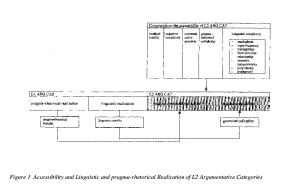
Figure 1 Accessibility and Linguistic and pragma-rhetorical Realization of L2 Argumentative Categories
As a result of implicationality, cognitive complexity, communicative necessity, pragma-rhetorical complexity and linguistic complexity, it may be be expected that the optional categories and subcategories will be used later in L2 production than the obligatory categories. Furthermore we may assume that less proficient L2 writers will presumably resort to linguistic simplification and reduction. This may affect the textual organization and lead to a preference for the use of syntactically coordinate argumentative categories, rather than syntactically subordinate categories. Another effect may be that the macro-argumentative structure in L2 is less hypotactically organized than its L1 equivalent. Proficient writers will be able to take advantage of their argumentative L1 skills. A further increase in L2 knowledge is likely to affect L2 text positively, but will not further increase the complexity of the macro-argumentative structure of the L2 texts.
4.2 Grammaticalization
A second assumption underlying the present study is that acquisition of the linguistic marking devices of L2 argumentative categories can be considered as a process of increasing grammaticalization (Figure 1). As a consequence, with regard to the linguistic realization of the argumentative categories L2 and L1 may differ in the degree of grammaticalization (cfr. Giacalone Ramat 1992; 1993; 1995; Skiba & Ditmar 1992).
As postulated by this grammaticalization theory, with regard to the acquisition of modality in L2 a first implicit pragmatic phase can be discerned in which all linguistic encoding is lacking and the modal meaning of the utterance has to be inferred from the direct verbal and non-verbal context (2a). In the second, lexical phase modality is realized with simple non-grammaticalized means, such as unmarked adverbs, performative and predicative constructions (2b). Only in the third, grammaticalized phase are some morpho-syntactic marking devices used, such as epistemic use of future tense and modal verbs, conditional and subjunctive mood, (2c).[v]
(2a)
– Che lavoro ti piacerebbe fare?
– A me piace come prima, come mio lavoro tecnica di laboratorio, interprete di medico, far questo lavoro a me piace molto, però
pazienza adesso.
[– What kind of work would you like to do?
– To me likes as before, as my work technician of laboratory interpreter for a doctor, to do this work to me liks much, but patience now.]
(2b)
– Cosa farai l’ultimo dell’anno?
– Io pensare così, prima lavorare, quando finisce lavoro sera no?, già tardi, forsa io va al ristorante mio parenti mangiare un po’ no, poi quando finisce tutti clienti imparare danza, fare così.
[– What will you be doing for New Year’s Eve?
– I think so, first work, when ends work evening already late, perhaps I go to restaurant my relatives eat a bit, then when finish all clients learn dance, do so.]
(2c)
– E questo monaco chi potrebbe essere?
– Il monaco dev‘essere un parente della famiglia.
[– And this monk who could he be?
– The munk must be a relative of the family.]
On the basis of grammaticalization we may hypothesize that L2 writers will make use of grammatically and lexically simpler structures than they do in L1. A second consequence is that L2 will contain more argumentative indicators and fewer other lexical and syntactic marking devices than L1, since linguistic realization by means of the latter will probably be more demanding than realization by an unmarked argumentative indicator (3a-3b).
(3a)
Italy in 1945 was little changed, outside of its major cities, since the time of Garibaldi and Cavour, because it was still predominantly a peasant country, of great and unspoiled natural beauty, of sleeping provincial cities, of enduring poverty, especially in the South.
(3b)
Italy in 1945 was little changed, outside of its major cities, since the time of Garibaldi and Cavour, being still predominantly a peasant country, of great and unspoiled natural beauty, of sleeping provincial cities, of enduring poverty, especially in the South.
4.3 Pragma-rhetorical devices and figures of speech
Finally it is assumed that pragma-rhetorical realization of L2 argumentative categories is complex for both the obligatory categories and the optional categories and subcategories, as stated in 4.1. The use of pragma-rhetorical devices and figures of speech with an indirect argumentative function, such as metaphors and rhetorical questions which may increase the illocutionary force of the argument is probably closely linked to cognitive and psychological factors, since one’s way of writing is part of one’s personality and reflects one’s perception of reality. L2 writers will therefore acquire these pragma-rhetorical devices only at a relatively late stage of the L2 acquisition process. Consequently, these indirectly argumentative devices are likely to play a minor role in the texts of intermediate L2 writers. Moreover, we may suppose that L2 production will be affected in some degree by the pragma-rhetorical and stylistic patterns and conventions of the mother tongue (Figure 1).
5. Results
In this section the results of the analysis of the occurrence of argumentative categories, the characteristics of the macro-argumentative structure and the use of argumentative indicators and other marking devices in L2 and L1 are presented and discussed.[vi]
5.1. Argumentative categories in L2 and L1
Table 2 reports the mean number of occurrences in L2 and L1 of the obligatory and optional argumentative categories and subcategories together with the level of significance of the differences between both languages.[vii]
Table 2 shows that with regard to the occurrence of the argumentative categories, very few significant differences between L2 and L1 can be observed. The number of Opinions in L2 is larger than that in L1. From this finding we cannot infer, though, that the L2 texts contain more unsubstantiated Opinions, since a comparison of the numerical relation between Opinion and Argument in L2 and L1 shows that this difference is statistically not significant.
In L2 Reinforcement is realized more often as a co-ordinate (Reinforcement paratac.). Similarly, significantly more performatives are used by the writers to express modality (Qualificator perf.). Since performative constructions can be considered as simple non-grammatical modal devices, it might be concluded that linguistic simplification strategies apparently play a more important role in L2. However, there is no significant difference between L2 and L1 with regard to the total number of modal markers (Qualificator tot), nor to the cases in which Reinforcement is realized as a subordinate (Reinforcement hypotac.). Neither are there signs of linguistic simplification in L2 with respect to the Precisizer, since contrary to expectations, the subcategory Precisizer turns out to be more frequent in L2 than in L1.
Another difference between L2 and L1 is that the total number of argumentative components in L2 is significantly higher than in L1. A possible explanation is that L2 writers are more inclined to use simpler lexical and syntactic devices, because their linguistic and pragma-rhetorical tools are less elaborate.
The results show that, on the whole, there are only few differences in the occurrence of obligatory and optional categories and subcategories between L2 and L1. The assumption that the optional categories are used less in L2 than in L1, must therefore be rejected and evidence supporting the hypothesized effect of implicationality, cognitive complexity, communicative necessity, pragma-rhetorical complexity and linguistic complexity cannot be found.
Neither with regard to other characteristics of the macro-argumentative structure such as the use of hypotactic argumentation structures and the occurrence of subordinated argumentative constituents significant differences between L2 and L1 can be detected. This is also true for the number of general opinions and conclusions that are explicitly included in the texts and in the occurrence or absence of introductory non-argumentative text components.
5.2 Linguistic realization of argumentative categories in L2 and L1
A number of differences between the L2 and the L1 essays were found in the degree of grammaticalization and lexical complexity of the linguistic realization of the argumentative categories. Apart from performatives, L2 learners also use a larger number of simple predicative constructions and unmarked adverbs to express modality, such as è possibile, forse (it’s possible, maybe).
Syntactically simplified realizations of Reinforcement as Reinforcement paratac prove to be more frequent in L2 as well. Some differences in morphosyntactic complexity were detected in the realization of Condition, for instance in the use of tenses and verbal modes and in the use of conditional clauses. However, this does not apply to the use of other argumentative categories in L2 and L1, where no differences in the degree of grammaticalization were found.
As predicted by the grammaticalization theory, the total number of argumentative indicators in L2 turns out to be much higher than in L1. Nonetheless, the higher frequency of indicators in the L2 texts is not accompanied by a lower frequency of other lexical and syntactic marking devices, since these are also used more often in L2 (Table 3).
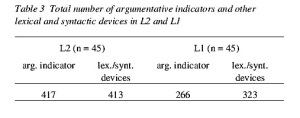
Table 3 – Total number of argumentative indicators and other lexical and syntactic devices in L2 and L1
In both L2 and L1 the learners show a preference for unmarked, colloquial, semantically unequivocal, polyvalent indicators with an easily identifiable equivalent in the mother tongue and a transparant relationship between form and function (ma, però; but, however). Input frequency and syntheticity seem to be less important. L1 influence manifests itself mainly in that indicators with no L1 equivalent are avoided in L2. Where they are not avoided, the syntactic and semantic domain of the indicators is often restricted, for instance in the case of infatti (as a matter of fact), used in L2 Italian only with affirmative and not with argumentative value, or the gerund (parlando, camminando; speaking, walking), reduced to the hypothetical type.[viii]
5.3 Pragma-rhetorical realization
Concerning the textual organization in L2 and L1 also the essays written by the native writers of Italian were analyzed. The comparison of L2 Italian, L1 Dutch and L1 Italian shows that the differences between L2 Italian and L1 Dutch are rather small, while the differences with regard to L1 Italian are numerous. The use of metaphors and rhetorical questions appears to be similar in L2 Italian and L1 Dutch, but fundamentally different in L1 Italian. Newly created metaphors only occur in L1-Italian. In L2 Italian and in Dutch they are completely absent. Similarly, lexicalized, standardized metaphors are used much more frequently in native Italian than in L2 Italian or in Dutch (Table 4). The same is true for the number of indirectly argumentative rhetorical questions (Table 5). As a consequence, evidence for the hypothesis that L2 writers make greater use of this type of
pragma-rhetorical devices in L2 than they do in their mother tongue was not found. On the other hand, the assumption that the use of pragma-rhetorical devices in L2 is both quantitatively and qualitatively determined by their role in L1, is confirmed by the data.
Both L2 Italian and L1 Dutch are characterized by juxtaposition and by the use of paratactical, asyndetic connections, few punctuation markers and a relatively small number of unmarked colloquial indicators. This is also true for L1 Italian. However, on average the sentences in the native Italian essays are much longer than in L2 Italian and in L1 Dutch, as shown by Table 6.
The considerably higher mean length of the sentences in native Italian does not seem to be caused by syntactic factors, but is probably due to pragma-rhetorical and stylistic factors, such as the accumulation of modal nouns and adjectives, and a large number of enumerations. Generally speaking, the native Italian texts display a greater lexical variety than the Dutch essays. The higher number of modality markers used by the writers in the Italian L1 texts also gives the impression of greater emotional involvement, as shown by the examples 4a and 4b.
(4a) L2 Italian
La domanda che l’Italia ha perso il suo fascino, ha due lati. Si può dire di sì, perché ci sono molto scippi, c’è sporco, i monumenti sono spesso in restauro e i musei sono chiusi. Anch’io ho avuto questo esperienza. Al ultimo giorno delle mie vacanze volevo visitare l’Arena di Verona. E era chiusa. Volevo ammirare le statue che sono accanto agli Uffizi a Firenze (ho dimenticato il suo nome) ma potevo vedere solo le impalcature. Non mi piaceva molto a questo momento. Le campeggi sono spesso sporchi, non c’è l’acqua potabile. C’è solo il vicino che ti spia tutto il giorno. Tutto questo sciupa il mio buon umore per un’ora o due, ma dopo, non è più possibile. Perché, dall’altra parte c’è sempre il sole, ci restano molte belle cose da vedere, le piatte deliziose, il paesaggio si bello, gli edifici medievale che emanano una sfera di una tutta altra vita. La gente sulle strade che hanno un buon umore, si ride, si parla, si vive! […]
[The question of whether Italy has lost its fascination, has two sides. It could be said that Italy has lost it, because there are many pick-pockets, it’s dirty, the tourist sights are under repair and the museums closed. I had the same experience. On the last day of my holiday in Verona I wanted to visit the Arena. It was closed. I wanted to admire the statues near to the Uffizi Galllery in Florence (I forget the name), but the only thing I saw was scaffolding. I wasn’t very pleased at the time. The camp sites are often dirty, there is no drinking water. There is only your neighbour spying on you the whole day. All these things put me in a bad mood for an hour or two, but afterwards, that’s no longer possible. Because, on the other hand, there is always the sun, there are many beautiful things to see, delicious food, a beautiful scenery, medieval buildings suggesting a completely different way of life. People on the street, everybody in a good humour, laughing, talking, just being alive! […]].
(4b) L1 Italian
[…] E quando troppi occhi o mani si impossessano della bellezza, questa si sciupa, diventa piú opaca, perché a portata di tutti. Ma per chi sa apprezzare dal di dentro il mistero dei suoi vicoli, la sgargiata vividezza del suo sole, il vocio di un mercato popolare, i suoi dialetti, l’Italia resta una terra da amare. Una terra non è marcata dai suoi uomini politici, inetti da molti secoli, ma dalle sue masse popolari, dalla loro forza di adattamento, dalla loro volontà di dare a tutti gli aspetti della vita quotidiana quel tocco di gioia di vivere che è indispensabile per la sopravvivenza dell’individuo e del gruppo in qualsiasi società […]. Il mio lungo soggiorno all’estero, in un mondo fatto di interni di casa, di salde amicizie e non di amicizie frettolose come si legano in Italia, mi fa sempre piú ammirare la mia terra e conservarne un ricordo indelibile, come del primo amore vissuto nei primi calori primaverili. Decisamente, l’Italia non ha perso il suo fascino per me.
[[…] And when too many eyes and hands take possession of beauty, it gets spoiled and becomes more opaque, because it has come within everbody’s reach. But for those who are able to appreciate from the inside the mystery of the back streets, the exhuberant vivacity of the sun, the sounds and voices of a local market, the dialects, Italy is still a country to love. A country is not characterized by its politicians, who have been worthless for many centuries already, but by the masses, people with great adaptability, with a will to give to every aspect of daily life that touch of joyfulnes, indispensable for the survival of the individual and the group in any society […]. My long stay abroad, in a world of interiors of houses, of staunch friendships instead of superficial friendships like the ones in Italy, has made me admire my country more and more and I keep an enduring memory of it, like a first love, in the first warmth of spring. For me Italy has certainly not lost its fascination.]
6. Discussion
The study makes clear that there are very few substantial differences between L2 and L1 in the complexity of the argument and the occurrence of the various argumentative categories. Supporting evidence for the hypothesized order in which the argumentative categories are used in L2 production was not found. Future research should make clear to what extent this similarity between L2 and L1 should be attributed to the degree of L2 proficiency of the writers and to the relative proximity of the proficiency levels 1, 2 and 3. The intermediate L2 writers may already have passed the threshold level of linguistic competence required for the use of the L2 argumentative categories. Further research should attempt to establish whether the influence of implicationality, cognitive complexity, communicative necessity, pragma-rhetorical complexity and linguistic complexity can be detected in texts written by beginners and whether there are other factors which may affect the accessibility of the L2 argumentative categories.
The study also shows various grounds for rejecting the grammaticalization theory in its present form. Further research should establish whether particular aspects of the grammaticalization theory might nonetheless be useful in the description of the acquisition of the L2 lexical and syntactic marking devices. The study also makes clear that the majority of differences between L2 and L1 writers resides in the control and manipulation of textual and pragma-rhetorical rather than grammatical strategies. Also the sharp distinction made by Giacalone Ramat et al. between lexicon and syntaxis proves to be theoretically and practically untenable. For these reasons a third, textual phase should perhaps be proposed, rather than a separate grammaticalized phase as postulated by the grammaticalization theory. The linguistic acquisition of the L2 argumentative categories could then be described in terms of a process which starts at the pragmatic level and leads via the lexical-syntactic level to the textual level.
Finally, the study shows that the non-native character of the writing of intermediate L2 writers results in the first place from deviant pragma-rhetorical realizations of the argumentative categories. The type of linguistic realizations plays a relatively minor part. Further research should therefore focus first of all on these pragma-rhetorical realizations and the linguistic and pragma-rhetorical devices which writers have at their disposal to manipulate the emotional involvement of the reader, and secondly on the extent to which differences between L2 and L1 in lexical variety and the choice of modality markers are determined by the contrasting pragma-rhetorical conventions of L2 and L1.
NOTES
[i] The English translations are as close as possible to the Italian originals. The English may therefore sometimes be clumsy.
[ii]Cfr. Keenan and Comrie’s Accessibility Hierarchy (1977).
[iii] Cfr. Keenan and Comrie’s Accessibility Hierarchy (1977).
[iv] For a detailed discussion of these target language features see Vedder (1998).
[v] See for the examples 2a-2c Giacalone Ramat (1992: 310-311; 313; 315).
[vi] As for the occurrence of argumentative categories, the Italian and Dutch essays were compared statistically by means of a t-test and a Wilcoxon-test; possible group effects were measured by a multiple range test (Student-Newman-Keuls post hoc test).
[vii] The symbol n indicates the number of participants, while p – value stands for the degree of probability.
[viii] The following eight types of gerunds can be distinguished in native Italian: temporal; hypothetical, coordinate-narrative; coordinate-evaluative; hypothetical, instrumental; predicative and concessive (Lonzi: 1991: 483-570).
REFERENCES
Alderson, J.C. (1984). Reading in a foreign language: a reading problem or a language problem? In: J.C. Alderson & A.H. Urquhart (eds.), Reading in a foreign language. London: Longman, 1-14.
Bereiter, C. & M. Scardamalia (1987). The psychology of written composition. Hillsdale, NJ/London: Lawrence Erlbaum Associates.
Bernhardt, E.B. & M.L. Kamil (1995). Interpreting relationships between L1 and L2 reading: Consolidating the Linguistic Threshold and the Linguistic Interdependence Hypotheses. Applied Linguistics 16, 15-34.
Clarke, M.A. (1979). Reading in Spanish and English: Evidence from adult ESL students. Language Learning 29, 121-150.
Cumming, A. (1989). Writing expertise and second-language proficiency. Language Learning 39, 81-141.
Cziko, G.A. (1980). Language competence and reading strategies: A comparison of first- and second-language oral reading errors. Language Learning 30, 101-116.
Eemeren, F.H. van & R. Grootendorst (1984). Speech acts in argumentative discussions. A theoretical model for the analysis of discussions directed towards solving conflicts of opinion. Dordrecht/Cinnaminson: Foris Publications, PDA 1.
Eemeren, F.H. van & R. Grootendorst (1992). Argumentation, communication, and fallacies. A pragma-dialectical perspective. Hillsdale, NJ: Lawrence Erlbaum Associates.
Eemeren, F.H. van, Grootendorst, R. & F. Snoeck Henkemans (1996). Fundamentals of argumentation theory. A handbook of backgrounds and contemporary developments. Mahwah, NJ: Lawrence Erlbaum Associates.
Flower, L. S. & J. R. Hayes (1981). Plans that guide the composing process. In: C. Frederiksen & J. Dominic (eds.), Writing: The nature, development, and teaching of written communication. Vol.2. Hillsdale, NJ: Lawrence Erlbaum Associates, 39-58.
Garssen, B. (1997). Argumentatieschema’s in pragma-dialectisch perspectief. Een theoretisch en empirisch onderzoek. Amsterdam: IFOTT 32.
Giacalone Ramat, A. (1992). Grammaticalization processes in the area of temporal and modal relations. Studies in Second Language Acquisition 14, 297-322.
Giacalone Ramat, A. (1993). Sur quelques manifestations de la grammaticalisation dans l’acquisition de l’italien comme deuxième langue. AILE 2, 173-200.
Giacalone Ramat, A. (1995). Function and form of modality in learner Italian. In: A. Giacalone Ramat (ed.), From pragmatics to syntax. Modality in second language acquisition. Tübingen: Gunter Narr Verlag, 269-293.
Kasper, G. (1992). Pragmatic transfer. Second Language Research 8, 203-231.
Kasper, G. & R. Schmidt (1996). Developmental issues in interlanguage pragmatics. Studies in Second Language Acquisition 18, 149-169.
Keenan, E. & B. Comrie (1977). Noun phrase accessibility and universal grammar. Linguistic Inquiry 8, 63-99.
Lo Cascio, V. (1991a). Grammatica dell’argomentare. Strategie e strutture. Firenze: La Nuova Italia.
Lo Cascio, V. (1991b). Proposals for an argumentative grammar. In: F.H. van Eemeren, R. Grootendorst, J.A. Blair & C.A. Willard (eds.), Proceedings of the second international conference on argumentation. Vol.IA. Amsterdam: SIC SAT, 530-545.
Lo Cascio, V. (1995). Categories and modal function in counterargumentation. In: Reconstruction and application. Proceedings of the third ISSA conference on argumentation. Vol.III. Amsterdam: SIC SAT, 78-95.
Lonzi, L. (1991). Frasi subordinate al gerundio. In: L. Renzi & G. Salvi (eds.), Grande grammatica italiana di consultazione. Vol.II. Bologna: Il Mulino, 571-592.
Odlin, T. (1989). Language transfer. Cambridge: Cambridge University Press.
Schoonen, R., J.H. Hulstijn, & B. Bossers (1998; forthcoming). Language-specific and metacognitive knowledge in native and foreign language reading comprehension: An empirical study among Dutch students in grades 6, 8 and 10. Language Learning 48/1.
Skiba, R. & N. Dittmar (1992). Pragmatic, semantic and syntactic constraints and grammaticalization: A longitudinal perspective. Studies in Second Language Acquisition 14, 323-349.
Toulmin, S. E. (1958/1964). The uses of argument, 2nd ed., Cambridge: Cambridge University Press.
Vedder, I. (1996). The acquisition of argumentation and the use of argumentative indicators in L2 by Dutch adult learners of Italian. In: The sociolinguistic dimension in the teaching and learning of modern languages. Proceedings of the 11th international conference, GALA 7. Thessaloniki: University Press, 407-412.
Vedder, I. (1998). Dunque l’Italia ha perso il suo fascino? Io penso di no. Argumenterend schrijven in een tweede taal. Een analyse van argumentatieve teksten van Nederlandse studenten Italiaans. University of Amsterdam: IFOTT/LOT 2.
Vignaux, G. (1991). A cognitive model of argumentation. Proceedings of the second international conference on argumentation. Vol.IA. Amsterdam: SIC SAT, 303-310
You May Also Like
Comments
Leave a Reply
